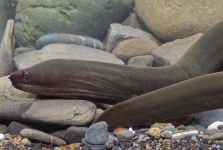- Thread Author
- #1
- Joined
- Sep 25, 2023
- Messages
- 30,143
- Reaction score
- 2,588
- Trophy Points
- 177
- Location
- Philippines
- D Bucks
- 💵0.422750
- Referral Credit
- 100
According to the report, researchers have found a new species of moray eel living in the murky river mouths of the Philippines, Japan, Taiwan, southern Java, and Fiji. The species – described in the journal Zookeys and has been named after Hades, the Greek god of the underworld, due to its striking, dark coloring and its preference for shadowy places
The report said that around 230 species of moray eels are known worldwide. The majority of these are marine dwellers, with just one species confirmed to live primarily in freshwater such are the slender giant moray (Strophidon sathete), which can tolerate brackish conditions and occasionally venture into river mouths.
However, morays specifically adapted to estuarine environments are exceedingly rare, making Hades’ snake moray an intriguing discovery. The find came about by chance when researchers from National Sun Yat-Sen University were exploring the Puerto Princesa Subterranean River in the Philippines.
The report added that they found that it prefers to burrow tail-first, a rare trait among moray eels. It is also highly sensitive to light, consistently seeking out shelter when exposed to brightness. Its small eyes and reduced number of head sensory pores suggest that it has adapted to navigate and hunt in low-light, sediment-heavy environments, relying more on chemoreception (responding to chemical stimuli, primarily using taste and smell) than vision to detect prey or evade predators.

Source: BBC Wildlife
The report said that around 230 species of moray eels are known worldwide. The majority of these are marine dwellers, with just one species confirmed to live primarily in freshwater such are the slender giant moray (Strophidon sathete), which can tolerate brackish conditions and occasionally venture into river mouths.
However, morays specifically adapted to estuarine environments are exceedingly rare, making Hades’ snake moray an intriguing discovery. The find came about by chance when researchers from National Sun Yat-Sen University were exploring the Puerto Princesa Subterranean River in the Philippines.
The report added that they found that it prefers to burrow tail-first, a rare trait among moray eels. It is also highly sensitive to light, consistently seeking out shelter when exposed to brightness. Its small eyes and reduced number of head sensory pores suggest that it has adapted to navigate and hunt in low-light, sediment-heavy environments, relying more on chemoreception (responding to chemical stimuli, primarily using taste and smell) than vision to detect prey or evade predators.

Source: BBC Wildlife


